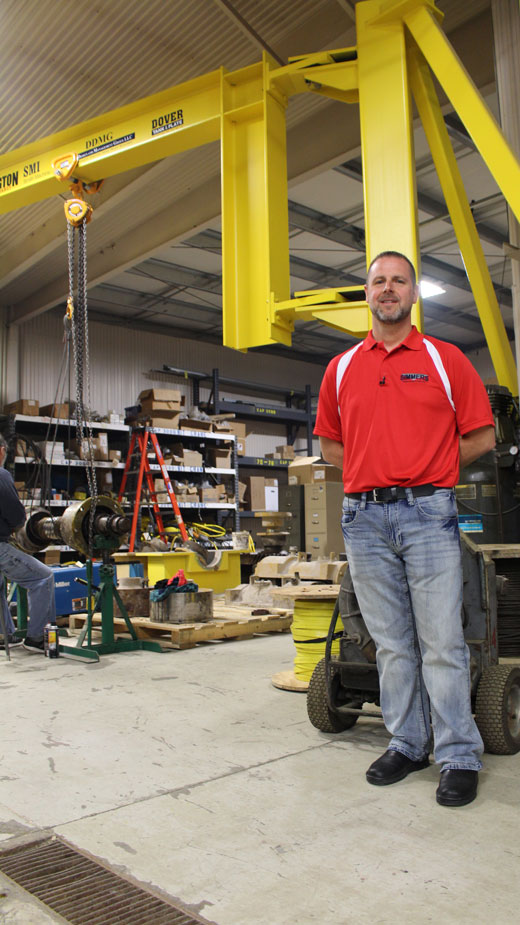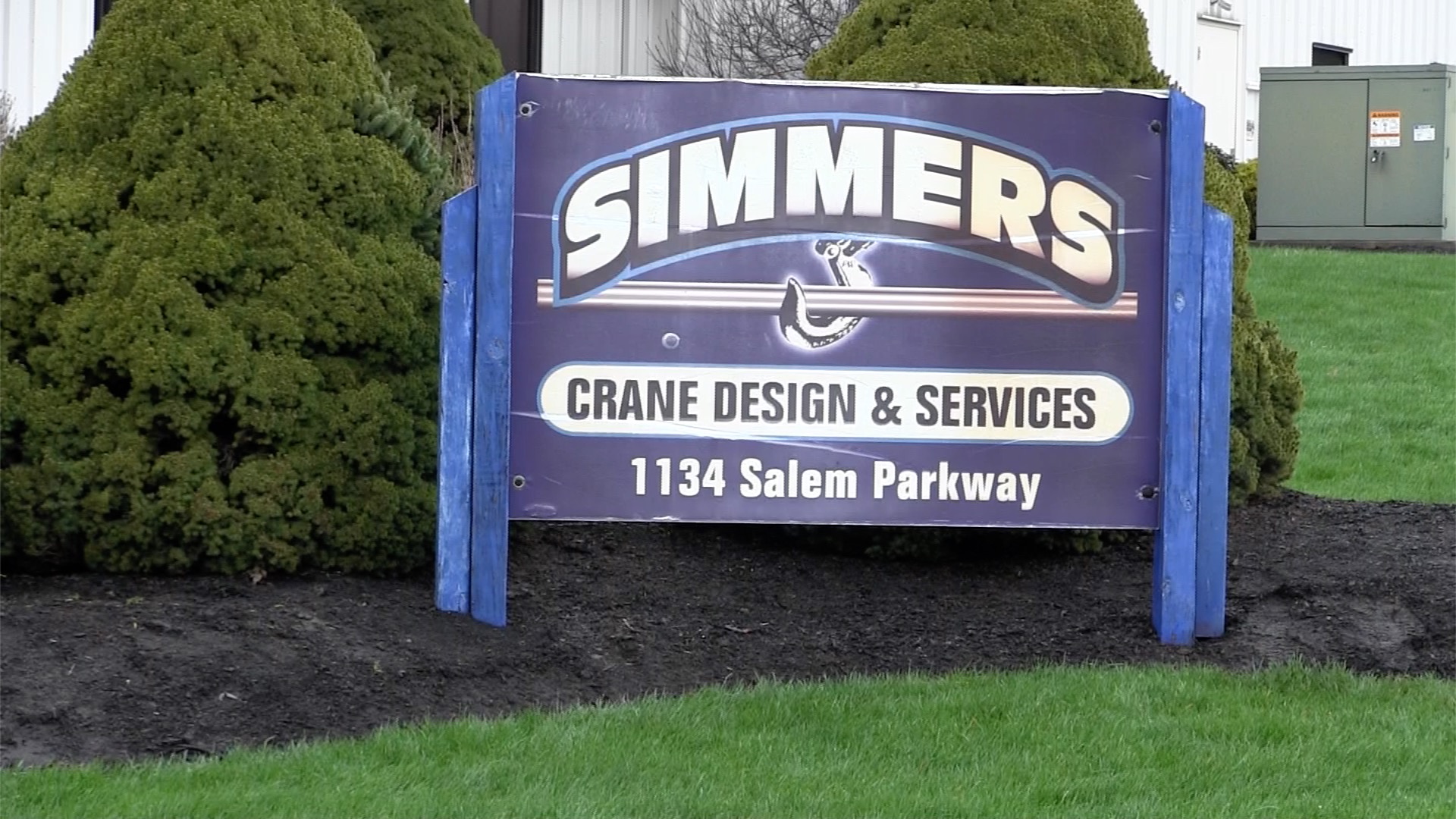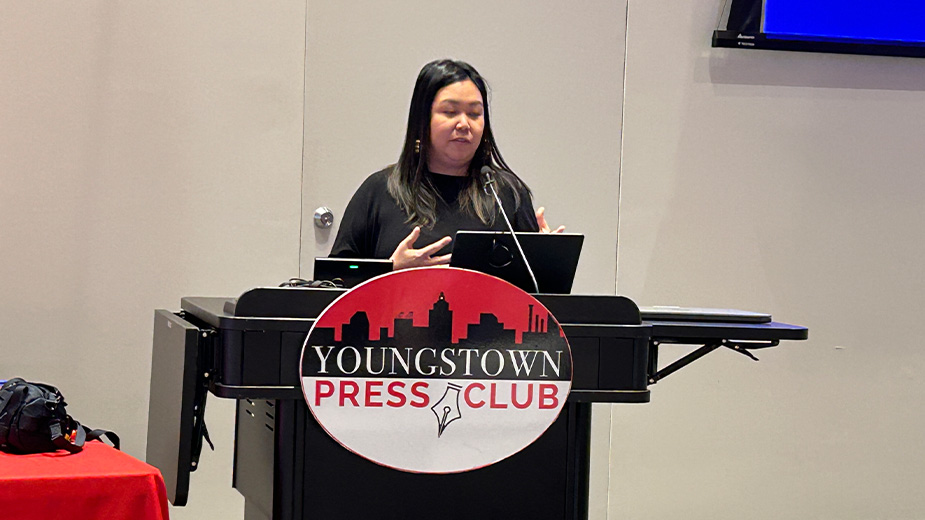Simmers Leverages Expertise, Interns to Hoist Expansion
SALEM, Ohio — In the shop at Simmers Crane Design & Services in Salem, an employee works on a piece of equipment suspended from a two-ton-capacity jib crane. The crane bears the logos of several regional companies – project sponsors for the crane that was built by students in the engineering program at Youngstown State University.
“That was a very large project here. They had to make it so we could move it,” says Chad Thorne, service manager at Simmers. “They did a great job.”
The crane will be moved to an expansion project for the company: a 20,000-square-foot building next door to its headquarters at 1134 Salem Parkway. Simmers will move its entire service division there, allowing it to produce more cranes and hire more people, Thorne says.
In recent years, the specialty-engineering company that builds, services, repairs and inspects cranes for its customers has relied heavily on engineering graduates and interns from YSU, says its president and CEO, Randy Stull. Of the 70-plus people who work at Simmers, about half are YSU graduates, he says.

“We have found some excellent individuals out of the YSU engineering program,” Stull says. “I can introduce you to 30, 40, 50 people that fit that mold who have been here for several years.”
Simmers has hired a few YSU graduates every other year, Stull says. Having access to a local talent pool like that is “incredibly valuable” to a small business.
“When you look at what YSU is doing in their engineering program, they’re preparing young individuals to succeed in industries such as ours,” he says. “I’ve noticed over the last 20 years that the individuals coming out aren’t just engineering, crunch-numbers students. They’re much more rounded. So their communication skills have improved … The curriculum there is very good.”
And Simmers puts graduates to work doing what they were educated to do, says Mark Kastner, vice president and general manager for the company. While other, larger companies “are going to put them in inventory management or something that they really didn’t do in their curriculums,” Simmers lets them use what they learned.
“We expect them to rise to the occasion,” Kastner says. “It’s almost like we are asking people to run their own business. Really it’s worked out well – it’s been a great formula for our success.”
Creating a “strong foundation at the corporate location” was imperative for that success, Stull says. The company’s engineering group is the “cornerstone of that foundation,” with its ability to analyze any overhead crane and its components, identify whether they are up to code and recommend any upgrades, he says.
Since the late 1980s and early ’90s, Simmers expanded from its original site in Canfield to operating satellite locations in Buffalo, N.Y., Cleveland, Erie, Pa., Rock Island and Chicago, Ill., Milwaukee and Roanoke, Texas.
“The owners wanted to expand the business,” says Stull, who joined the company in 1991. “It’s been a steady improvement in business as we open an operation and grow it in that region.”
What was founded as a regional company in 1958 by Charles Simmers now serves the contiguous 48 states and Mexico, and employs nearly 300 full- and part-time across all locations. Simmers primarily serves the steel and aluminum industries, up to and including Fortune 500 companies, Stull says. It also works in the power-generation industry, particularly with nuclear and fossil fuel plants in the eastern United States, as well as heavy manufacturing.
“General Electric has been one of our big customers over the years,” he says.
Hiring has played a critical role in managing that growth, Stull says. After identifying a market “where there’s an appetite for what we provide,” the company works to hire the right people in that market.
“It’s more than just putting a peg in a hole,” Stull says. “You’ve got to find the right person with the right character makeup, skill sets, that drive that creativity and initiative to put them in those key roles.”
In addition to good hiring practices, maintaining effective communication is important when managing a workforce spread out over several locations. Mistakes are made, Stull says, but if those mistakes and their solutions aren’t shared with co-workers, “It’s likely going to happen again.”
Stull says he maintains an open-door communications policy, so if a field worker sees an issue, “He can pick up the phone and call me, Mark [Kastner], any one of the team leaders or the managers and say ‘Hey, we’ve got a problem here.’ And then we need to respond to that.”
Revenue is up 7% annually on average, but Simmers enjoyed a record 13% increase in 2018, he says, “and we’ve had a series of record years as we’ve been growing.”
This year, he expects it to be “OK,” although Stull says he’s cautiously optimistic for 2020. While not expecting any significant drop in business, he anticipates there could be a pause.
“We’ve got an election coming up,” he says. “Creates a lot of uncertainty and we’ve weathered them in the past. It’s just going to be a challenging year I think. Markets are solid. I think companies are going to continue to forge ahead.”
Editor’s note:
This is the third in a four-part story entitled “They Grew from Small to BIG” published in the May 2019 edition of The Business Journal. CLICK HERE to order your copy and stay tuned for other small-to-big stories and videos on our website.
More “Small to BIG”
Future is Clear for Central One Optical
Aim Drives Growth With Diversification
Copyright 2024 The Business Journal, Youngstown, Ohio.



